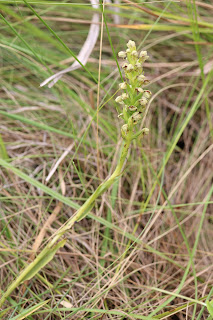We set off on both weeks to explore what was flowering at Cubica Heights. The Outeniqua Falls was pumping down with water. Agapanthus grew on the slopes and were in flower. The wind was relentless on the first outing and quite impossible to capture the flowers on a camera without them being in a blur. It is amazing to see the difference from one week to another what is in flower as the flowers we saw in the first week were not flowering in the second. Everything in nature has its own timing and one has to be there in order to not miss out. In the first week the Hesperantha and orchids were in flower and in the second Cephalaria humilis was abundant in the grasslands.
 |
Hesperantha lactea IRIDACEAE
South African endemic
|
 |
Outeniqua Falls
|
 |
Gnidia coriacea
THYMELAEACEAE
South African endemic
|
 |
Tephrosia bachmannii
FABACEAE
Vulnerable A2c
South African endemic
|
"Tephros" is a Greek word and it refers to the ash-coloured leaves of these plants.
 |
Oedera pungens
ASTERACEAE
Oedera is named after a Danish botanist George Christian Oeder.
The leaves are often fragrant and unpalatable for stock grazing.
|
 |
Polygala refracta
POLYGALACEAE |
 |
Zornia linearis
FABACEAE |
 |
Brownleea coerulea
ORCHIDACEAE
This orchid is found in shaded habitats and in moss and on rock ledges. It is pollinated by long-probiscid flies and flowers between February and April.
 |


 |
Bulbophyllum scaberulum var. scaberulum
ORCHIDACEAE |
Bulbophyllum scaberulum var. scaberulum is distinguishable from Bulbophyllum sandersonii by the concave, upward-poining median sepal and linear, outward-pointing petals without a club-shaped tip. This orchid s found in light shade and moist forests and flowers between October and December.
.
 |
| Streptocarpus polyanthus subsp. polyanthus (I-Nat) South African endemic GESNERIACEAE |
 |
Stenoglottis fimbriata subsp. fimbriata
ORCHIDACEAE
South African endemic
This orchid is a very variable species, both in size and coloration of all parts. It flowers between January and March. |
 |
Streptocarpus formosus
GESNERIACEAE
Rare
South African endemic

 |
 |
Hypoxis membranacea
HYPOXIDACEAE
The name Hypoxis is derived from a Greek word hypo, meaning ‘below’ and oxys, meaning ‘sharp’ or ‘pointed’ and referring to the pointed base of the ovary or fruit. The species name membranacea refers to the thin leaves which are almost translucent and delicate. The flowers are small and delicate and found in moist areas. The flower buds are hairy and it flowers between October and January. In grasslands it is adapted to wild flowrs and, like many members of the family, Hypoxis membranacea is deciduous and can survive grassland fires. During the fire season it becomes dormant, with the corm escaping the flames by lying underground and eventually re-sprouting after the fire. The flowers are pollinated by solitary and honey bees.
|
 |
Chlorophytum modestum
Anthericaceae

 |
 |
Peperomia tetraphylla
PIPERACEAE
Peperomia tetraphylla is from the pepper family. The generic name Peperomia is derived from the Greek peperi, meaning ‘pepper’ and homoios, meaning ‘resembling’, referring to it being similar to the true pepper, Piper. The specific epithet tetraphylla is from the Greek tetra, meaning ‘square’ or ‘four’ and phylla, meaning ‘leaf’ in reference to the usually four leaves per node.
|
 |
Polygala macowaniana
POLYGALACEAE
South African endemic
|
 |
Polystachya concreta
ORCHIDACEAE
|
 |
Plectranthus saccatus subsp. pondoensis
LAMIACEAE
South African endemic
 | Taking a good look at Cephalaria humilis.
|
|
 |
Cephalaria humilis
DIPSACACEAE
South African endemic |
 |
Ceropegia linearis subsp. linearis
APOCYNACEAE
|
 |
Pavetta natalensis
RUBIACEAE
|
 |
Liparis bowkeri
ORCHIDACEAE
 |
 |
Stenoglottis macloughlinii
ORCHIDACEAE
|
 |
Olea capensis
OLEACEAE
South African endemic |
 |
| Pseudoscolopia polyantha |
SALICACEAE
Near Threatened B1ab(iii,v)
South African endemic
 |
Habenaria lithophila
ORCHIDACEAE |
 |
Alf and Hillary observing Indigastrum fastigiatum
|
 |
Indigastrum fastigiatum
FABACEAE |
 |
Aeollanthus parvifolius
LAMIACEAE |
 |
Tephrosia polystachya
FABACEAE |
 |
Zaluzianskya angustifolia
SCROPHULARIACEAE
South African endemic |
 |
| Alf and Anne removing invasives growing in the reserve. |
 |
Solanum nigrum
SOLANACEAE |
 |
Selago tarachodes
SCROPHULARIACEAE
South African endemic |
 |
Tridactyle bicaudata subsp. rupestris
ORCHIDACEAE
South African endemic
|
 |
Rangaeris muscicola
ORCHIDACEAE |
 |
Agapanthus campanulatus subsp. campanulatus
AGAPANTHACEAE |
 |
Searsia pondoensis
ANACARDIACEAE
South African endemic
|
 |
Indigofera pondoensis
FABACEAE |
 |
Crassula pellucida subsp. brachypetala
CRASSULACEAE
|
 |
Indigofera abbottii
FABACEAE |

























































































































